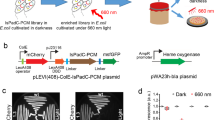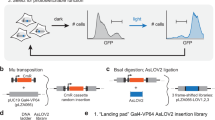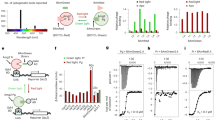Abstract
Near-infrared (NIR, 740–780 nm) optogenetic systems are well-suited to spectral multiplexing with blue-light-controlled tools. Here, we present two protocols, one for regulation of gene transcription and another for control of protein localization, that use a NIR-responsive bacterial phytochrome BphP1–QPAS1 optogenetic pair. In the first protocol, cells are transfected with the optogenetic constructs for independently controlling gene transcription by NIR (BphP1–QPAS1) and blue (LightOn) light. The NIR and blue-light-controlled gene transcription systems show minimal spectral crosstalk and induce a 35- to 40-fold increase in reporter gene expression. In the second protocol, the BphP1–QPAS1 pair is combined with a light-oxygen-voltage-sensing (LOV) domain-based construct into a single optogenetic tool, termed iRIS. This dual-light-controllable protein localization tool allows tridirectional protein translocation among the cytoplasm, nucleus and plasma membrane. Both procedures can be performed within 3–5 d. Use of NIR light–controlled optogenetic systems should advance basic and biomedical research.
This is a preview of subscription content, access via your institution
Access options
Access Nature and 54 other Nature Portfolio journals
Get Nature+, our best-value online-access subscription
$29.99 / 30 days
cancel any time
Subscribe to this journal
Receive 12 print issues and online access
$259.00 per year
only $21.58 per issue
Buy this article
- Purchase on Springer Link
- Instant access to full article PDF
Prices may be subject to local taxes which are calculated during checkout






Similar content being viewed by others
References
Taslimi, A. et al. Optimized second-generation CRY2-CIB dimerizers and photoactivatable Cre recombinase. Nat. Chem. Biol. 12, 425–430 (2016).
Wang, H. et al. LOVTRAP: an optogenetic system for photoinduced protein dissociation. Nat. Methods 13, 755–758 (2016).
Wang, X., Chen, X. & Yang, Y. Spatiotemporal control of gene expression by a light-switchable transgene system. Nat. Methods 9, 266–269 (2012).
Kaberniuk, A.A., Shemetov, A.A. & Verkhusha, V.V. A bacterial phytochrome-based optogenetic system controllable with near-infrared light. Nat. Methods 13, 591–597 (2016).
Redchuk, T.A., Omelina, E.S., Chernov, K.G. & Verkhusha, V.V. Near-infrared optogenetic pair for protein regulation and spectral multiplexing. Nat. Chem. Biol. 13, 633–639 (2017).
Shcherbakova, D.M., Shemetov, A.A., Kaberniuk, A.A. & Verkhusha, V.V. Natural photoreceptors as a source of fluorescent proteins, biosensors, and optogenetic tools. Annu. Rev. Biochem. 84, 519–550 (2015).
Ulijasz, A.T. & Vierstra, R.D. Phytochrome structure and photochemistry: recent advances toward a complete molecular picture. Curr. Opin. Plant Biol. 14, 498–506 (2011).
Piatkevich, K.D., Subach, F.V. & Verkhusha, V.V. Engineering of bacterial phytochromes for near-infrared imaging, sensing, and light-control in mammals. Chem. Soc. Rev. 42, 3441–3452 (2013).
Tran, M.T. et al. In vivo image analysis using iRFP transgenic mice. Exp. Anim. 63, 311–319 (2014).
Weissleder, R. & Ntziachristos, V. Shedding light onto live molecular targets. Nat. Med. 9, 123–128 (2003).
Jacques, S.L. Optical properties of biological tissues: a review. Phys. Med. Biol. 58, R37–R61 (2013).
Lewandoski, M. Conditional control of gene expression in the mouse. Nat. Rev. Genet. 2, 743–755 (2001).
Asakawa, K. & Kawakami, K. Targeted gene expression by the Gal4-UAS system in zebrafish. Dev. Growth Differ. 50, 391–399 (2008).
Halpern, M.E. et al. Gal4/UAS transgenic tools and their application to zebrafish. Zebrafish 5, 97–110 (2008).
Smart, A.D. et al. Engineering a light-activated caspase-3 for precise ablation of neurons in vivo. Proc. Natl. Acad. Sci. USA 114, E8174–E8183 (2017).
Harterink, M. et al. Light-controlled intracellular transport in Caenorhabditis elegans. Curr. Biol. 26, R153–R154 (2016).
Reade, A. et al. TAEL: a zebrafish-optimized optogenetic gene expression system with fine spatial and temporal control. Development 144, 345–355 (2017).
Buckley, C.E. et al. Reversible optogenetic control of subcellular protein localization in a live vertebrate embryo. Dev. Cell 36, 117–126 (2016).
Polstein, L.R., Juhas, M., Hanna, G., Bursac, N. & Gersbach, C.A. An engineered optogenetic switch for spatiotemporal control of gene expression, cell differentiation, and tissue morphogenesis. ACS Synth. Biol. 6, 2003–2013 (2017).
Fernandez-Rodriguez, J., Moser, F., Song, M. & Voigt, C.A. Engineering RGB color vision into Escherichia coli. Nat. Chem. Biol. 13, 706–708 (2017).
Muller, K. et al. Multi-chromatic control of mammalian gene expression and signaling. Nucleic Acids Res. 41, e124 (2013).
Reichhart, E., Ingles-Prieto, A., Tichy, A.M., McKenzie, C. & Janovjak, H. A phytochrome sensory domain permits receptor activation by red light. Angew Chem. Int. Ed. Engl. 55, 6339–6342 (2016).
Yazawa, M., Sadaghiani, A.M., Hsueh, B. & Dolmetsch, R.E. Induction of protein-protein interactions in live cells using light. Nat. Biotechnol. 27, 941–945 (2009).
Levskaya, A., Weiner, O.D., Lim, W.A. & Voigt, C.A. Spatiotemporal control of cell signalling using a light-switchable protein interaction. Nature 461, 997–1001 (2009).
Müller, K. et al. Synthesis of phycocyanobilin in mammalian cells. Chem. Commun. (Camb.) 49, 8970–8972 (2013).
Ryu, M.H. et al. Engineering adenylate cyclases regulated by near-infrared window light. Proc. Natl. Acad. Sci. USA 111, 10167–10172 (2014).
Gasser, C. et al. Engineering of a red-light-activated human cAMP/cGMP-specific phosphodiesterase. Proc. Natl. Acad. Sci. USA 111, 8803–8808 (2014).
Yumerefendi, H. et al. Control of protein activity and cell fate specification via light-mediated nuclear translocation. PLoS One 10, e0128443 (2015).
Kawano, F., Suzuki, H., Furuya, A. & Sato, M. Engineered pairs of distinct photoswitches for optogenetic control of cellular proteins. Nat. Commun. 6, 6256 (2015).
Taslimi, A. et al. An optimized optogenetic clustering tool for probing protein interaction and function. Nat. Commun. 5, 4925 (2014).
Chernov, K.G., Redchuk, T.A., Omelina, E.S. & Verkhusha, V.V. Near-infrared fluorescent proteins, biosensors, and optogenetic tools engineered from phytochromes. Chem. Rev. 117, 6423–6446 (2017).
Oliinyk, O.S., Chernov, K.G. & Verkhusha, V.V. Bacterial phytochromes, cyanobacteriochromes and allophycocyanins as a source of near-infrared fluorescent probes. Int. J. Mol. Sci. 18, 1691 (2017).
Albanese, C., Hulit, J., Sakamaki, T. & Pestell, R.G. Recent advances in inducible expression in transgenic mice. Semin. Cell Dev. Biol. 13, 129–141 (2002).
Pham, D.H., Moretti, P.A., Goodall, G.J. & Pitson, S.M. Attenuation of leakiness in doxycycline-inducible expression via incorporation of 3 AU-rich mRNA destabilizing elements. Biotechniques 45, 155–156 (2008).
Rennel, E. & Gerwins, P. How to make tetracycline-regulated transgene expression go on and off. Anal. Biochem. 309, 79–84 (2002).
Yu, G. et al. Optical manipulation of the alpha subunits of heterotrimeric G proteins using photoswitchable dimerization systems. Sci. Rep. 6, 35777 (2016).
Müller, K., Zurbriggen, M.D. & Weber, W. Control of gene expression using a red- and far-red light-responsive bi-stable toggle switch. Nat. Protoc. 9, 622–632 (2014).
Yumerefendi, H. et al. Light-induced nuclear export reveals rapid dynamics of epigenetic modifications. Nat. Chem. Biol. 12, 399–401 (2016).
Niopek, D. et al. Engineering light-inducible nuclear localization signals for precise spatiotemporal control of protein dynamics in living cells. Nat. Commun. 5, 4404 (2014).
Niopek, D., Wehler, P., Roensch, J., Eils, R. & Di Ventura, B. Optogenetic control of nuclear protein export. Nat. Commun. 7, 10624 (2016).
Fixen, K.R., Baker, A.W., Stojkovic, E.A., Beatty, J.T. & Harwood, C.S. Apo-bacteriophytochromes modulate bacterial photosynthesis in response to low light. Proc. Natl. Acad. Sci. USA 111, E237–E244 (2014).
Piatkevich, K. et al. Near-infrared fluorescent proteins engineered from bacterial phytochromes in neuroimaging. Biophys. J. 113, 2299–2309 (2017).
Schneider, C.A., Rasband, W.S. & Eliceiri, K.W. NIH Image to ImageJ: 25 years of image analysis. Nat. Methods 9, 671–675 (2012).
Schindelin, J. et al. Fiji: an open-source platform for biological-image analysis. Nat. Methods 9, 676–682 (2012).
Mátés, L. et al. Molecular evolution of a novel hyperactive sleeping beauty transposase enables robust stable gene transfer in vertebrates. Nat. Genet. 41, 753–761 (2009).
Liu, Z. et al. Systematic comparison of 2A peptides for cloning multi-genes in a polycistronic vector. Sci. Rep. 7, 2193 (2017).
Licursi, M., Christian, S.L., Pongnopparat, T. & Hirasawa, K. In vitro and in vivo comparison of viral and cellular internal ribosome entry sites for bicistronic vector expression. Gene Ther. 18, 631–636 (2011).
Pumroy, R.A. & Cingolani, G. Diversification of importin-α isoforms in cellular trafficking and disease states. Biochem. J. 466, 13–28 (2015).
Jozkowicz, A., Was, H. & Dulak, J. Heme oxygenase-1 in tumors: is it a false friend? Antioxid. Redox Signal 9, 2099–2117 (2007).
Filonov, G.S. et al. Bright and stable near-infrared fluorescent protein for in vivo imaging. Nat. Biotechnol. 29, 757–761 (2011).
Acknowledgements
This work was supported by grants GM122567 and NS103573 from the US National Institutes of Health, ERC-2013-ADG-340233 from the EU 7th Framework Programme (FP7), and grants 263371 and 266992 from the Academy of Finland.
Author information
Authors and Affiliations
Contributions
T.A.R. and A.A.K. performed the experiments. V.V.V. directed and planned the project, and, together with T.A.R. and A.A.K., designed the experiments, analyzed the data and wrote the manuscript.
Corresponding author
Ethics declarations
Competing interests
The authors declare no competing financial interests.
Integrated supplementary information
Supplementary Figure 1 Optical properties of mammalian tissues.
(a) Light penetration depth at 480 nm, 560 nm, 670 nm and 720 nm wavelengths in a muscle tissue. Adapted with permission from suppl. ref. 31, Nature Publishing Group (b) Molar extinction coefficient of oxygenated hemoglobin (HbO2) and deoxygenated hemoglobin (Hb). NIR tissue transparency window is shown as a red box. a adapted from Rumyantsev, K.A., Turoverov, K.K. & Verkhusha, V.V. Near-infrared bioluminescent proteins for two-color multimodal imaging. Sci. Rep. 6, 636588 (2016), Macmillan Publishers. b adapted with permission from Shcherbakova, D.M., Shemetov, A.A., Kaberniuk, A.A. & Verkhusha, V.V. Natural photoreceptors as a source of fluorescent proteins, biosensors, and optogenetic tools. Annu. Rev. Biochem., 84, 519–550, © 2015 by Annual Reviews, http://www.annualreviews.org.
Supplementary Figure 2 Light-induced transcription activation of the TetR-responsive system.
(a) Mode of function of the light-inducible transcription activation system. NIR light converts BphP1 into the Pr state and induces its heterodimerization with PpsR2. The NLS fused to PpsR2 facilitates translocation of the heterodimer to the nucleus where BphP1 fusions interact with tetO DNA repeats via its fused TetR. VP16 fused to PpsR2 recruits the transcription initiation complex and triggers transcription of a reporter gene. (b) Kinetics of the light-to-dark ratio of the SEAP signal detected in the culture media of a HeLa cell line stably expressing BphP1-mCherry-TetR and co-transfected with NLS-PpsR2-VP16-producing plasmid and pTRE-Tight-SEAP (7× tetO) reporter plasmid. Samples were illuminated by 740 nm pulsing light (30 s ON, 180 s OFF) of 1 mW cm−2. Adapted from ref. 4, Nature Publishing Group.
Supplementary Figure 3 Light activation of gene expression in mice.
(a) Rluc8 bioluminescence detected in mice with subcutaneously injected HeLa cells stably expressing BphP1-mCherry-TetR and co-transfected with the NLS-PpsR2-VP16-producing plasmid and pTRE–Tight–Rluc8 reporter plasmid kept either in the dark (top) or illuminated with 740/25 nm light of 1 mW cm−2 (bottom) for 48 h. (b) Rluc8 signals detected in dark-treated animals and in illuminated animals shown in (a) (n = 3; error bars are s.e.m.). All animal experiments in this Protocol were performed in an AAALAC approved facility according to the permission #20160313 approved by the Albert Einstein College of Medicine Animal Usage Committee. a adapted from ref. 4, Nature Publishing Group.
Supplementary Figure 4 Light-controlled protein targeting using the iRIS tool.
(a) iRIS relocalization to the nucleus in HeLa cells in response to 460 nm illumination. Scale bar, 10 μm. (b) Intensity profile of mCherry fluorescence of iRIS in the cell shown in (a) marked with a dashed line before (black line) and after (red line) 10 min of 460 nm illumination. (c) iRIS relocalization to the plasma membrane in HeLa cells under 740 nm illumination. Scale bar, 10 μm. (d) Intensity profile of mCherry fluorescence of iRIS in the cell shown in (c) marked with a dashed line before (black line) and after (red line) 10 min of 740 nm illumination. Adapted from ref. 5, Nature Publishing Group.
Supplementary Figure 5 Light-controlled protein targeting using the iRIS tool (example data).
iRIS relocalization to the nucleus (a) and to the plasma membrane (b) in HeLa cells in response to 460 nm and 740 nm illumination, respectively. Scale bar, 10 μm. Good and poor quality results are shown, white arrows indicate non-specific signals (mCherry fluorescence on the plasma membrane under 460 nm light (a) and in the nucleus under 740 nm light (b)).
Supplementary Figure 6 Gating of mCherry-positive cells.
Non-transfected HeLa cells (a) are used to create a gate for FACS sorting of mCherry positive cells (b).
Supplementary information
Supplementary Text and Figures
Supplementary Figures 1–6. (PDF 829 kb)
Rights and permissions
About this article
Cite this article
Redchuk, T., Kaberniuk, A. & Verkhusha, V. Near-infrared light–controlled systems for gene transcription regulation, protein targeting and spectral multiplexing. Nat Protoc 13, 1121–1136 (2018). https://doi.org/10.1038/nprot.2018.022
Published:
Issue Date:
DOI: https://doi.org/10.1038/nprot.2018.022
This article is cited by
-
Optogenetic manipulation and photoacoustic imaging using a near-infrared transgenic mouse model
Nature Communications (2022)
-
A guide to the optogenetic regulation of endogenous molecules
Nature Methods (2021)
-
Single-component near-infrared optogenetic systems for gene transcription regulation
Nature Communications (2021)
-
Optogenetic regulation of endogenous proteins
Nature Communications (2020)
Comments
By submitting a comment you agree to abide by our Terms and Community Guidelines. If you find something abusive or that does not comply with our terms or guidelines please flag it as inappropriate.



